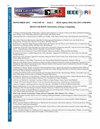利用合成电压矢量最大限度地降低采用 FCS-MPTC 的 FPOEW 感应电机的磁通和转矩纹波
IF 1.3
4区 工程技术
Q3 COMPUTER SCIENCE, INFORMATION SYSTEMS
引用次数: 0
摘要
本文介绍了一种采用有限控制组模型预测转矩控制(FCS-MPTC)的五相 OEWIM 新拓扑结构。这种拓扑结构通过减少磁通和转矩纹波以及最大限度地降低定子电流中的总谐波失真百分比 (%THD) 来提高稳态性能。此处提出的 FCS-MPTC 方案为两个逆变器采用了共享直流链路,确保共模电流为零,从而无需大型隔离变压器。这种拓扑结构可产生合成电压矢量 (SVV),该电压矢量由各个逆变器虚拟电压矢量相加而成。使用这种拓扑结构,电机绕组上的共模电压 (CMV) 将被消除。FCS-MPTC 的另一个显著特点是,它能够通过降低非转矩产生平面(x-y 平面)上的平均电压,抑制通过绕组的高次谐波电流。实验验证比较了 FCS-MPTC 与传统的三电平直接转矩控制 (TL-DTC) 和五电平直接转矩控制 (FL-DTC) 方法的有效性。本文章由计算机程序翻译,如有差异,请以英文原文为准。
Minimization of Flux and Torque Ripples of FPOEW Induction Motor with FCS-MPTC using Synthetic Voltage Vectors
This paper introduces a new topology for five-phase OEWIM using Finite Control Set Model Predictive Torque Control (FCS-MPTC). This topology shows the enhancement in the steady-state performance by reducing flux and torque ripples and minimizing the percentage of total harmonic distortion (%THD) in stator current. The FCS-MPTC scheme proposed here employs a shared DC link for both inverters, ensuring zero common mode current, thereby eliminating the need for a large isolation transformer. This topology generates Synthetic voltage vectors (SVV) which result from the vector summation of the individual inverter virtual voltage vectors. Common Mode Voltage (CMV) across the motor windings is nullified using this topology. Another notable aspect of FCS-MPTC is its ability to suppress high harmonic currents through the windings by reducing the average voltage in the non-torque-producing plane (x-y plane). Experimental validation compares the effectiveness of FCS-MPTC against traditional Three-Level Direct Torque Control (TL-DTC) and Five-Level Direct Torque Control (FL-DTC) methodologies
求助全文
通过发布文献求助,成功后即可免费获取论文全文。
去求助
来源期刊

IEEE Latin America Transactions
COMPUTER SCIENCE, INFORMATION SYSTEMS-ENGINEERING, ELECTRICAL & ELECTRONIC
CiteScore
3.50
自引率
7.70%
发文量
192
审稿时长
3-8 weeks
期刊介绍:
IEEE Latin America Transactions (IEEE LATAM) is an interdisciplinary journal focused on the dissemination of original and quality research papers / review articles in Spanish and Portuguese of emerging topics in three main areas: Computing, Electric Energy and Electronics. Some of the sub-areas of the journal are, but not limited to: Automatic control, communications, instrumentation, artificial intelligence, power and industrial electronics, fault diagnosis and detection, transportation electrification, internet of things, electrical machines, circuits and systems, biomedicine and biomedical / haptic applications, secure communications, robotics, sensors and actuators, computer networks, smart grids, among others.
 求助内容:
求助内容: 应助结果提醒方式:
应助结果提醒方式:


